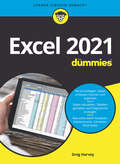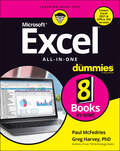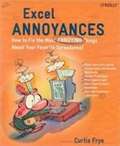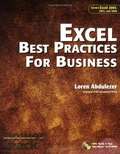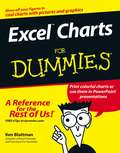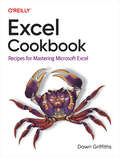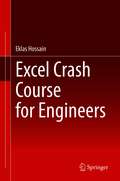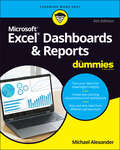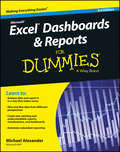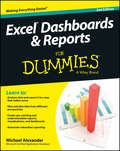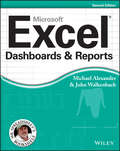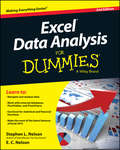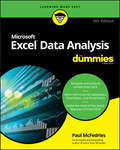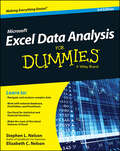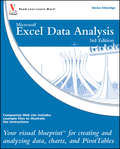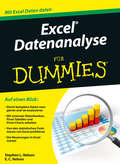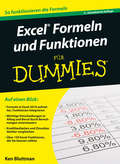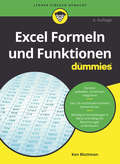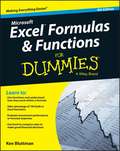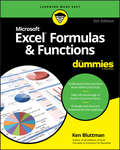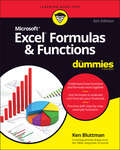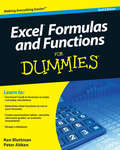- Table View
- List View
Excel 2021 für Dummies (Für Dummies)
by Greg HarveyWenn schon der Gedanke an Excel-Arbeitsblätter Ihnen Kopfschmerzen bereitet, ist dieses Buch das richtige für Sie. Im Handumdrehen können Sie Arbeitsblätter erstellen und bearbeiten, Zellen formatieren, Formeln eingeben, Diagramme erstellen und bearbeiten, Diagramme einfügen, Datenbankformulare entwerfen und vieles mehr. Außerdem erhalten Sie eine leicht verständliche Anleitung für fortgeschrittene Excel-Fertigkeiten, wie das Hinzufügen von Hyperlinks zu Arbeitsblättern, das Speichern von Arbeitsblättern als Webseiten, das Hinzufügen von Arbeitsblattdaten zu einer bestehenden Webseite und vieles mehr.
Excel 2022 Benutzerhandbuch fu r Einsteiger: Das leicht verständliche Microsoft Excel-Handbuch zum Erlernen des produktiven Umgangs mit Excel
by Janardhan MarappaWenn ja, sind Sie hier richtig! In diesem Buch lernen Sie die Grundlagen von Microsoft Excel, Excel-Anwendungen und -Terminologien, Excel-Formeln und -Funktionen, Excel-Tabellen und -Diagramme, Excel-Verknüpfungen und -Tricks und vieles mehr kennen. Die Sprache für Anfänger ist sehr einfach und die Erklärungen werden von vielen Bildern begleitet, um den Weg flüssig und verständlich zu machen. Selbst wenn Sie noch nie mit Excel gearbeitet haben, wird dieses Buch Sie durch die Grundlagen führen, und wenn Sie es schon einmal benutzt haben, werden Sie noch mehr Informationen erhalten. Es ist ein komplettes Handbuch für diejenigen, die gerade erst mit Excel anfangen und all die kleinen Tastaturtricks und Tastenkombinationen verstehen wollen. Darüber hinaus bietet das Buch einfache Tastenkombinationen und Schritt-für-Schritt-Anleitungen. Verschwenden Sie keine Zeit mehr! Steigen Sie sofort ein. Und noch etwas: Am Ende des Buches erhalten Sie einen kostenlosen Zugang zu einem GESCHENK, das Ihnen helfen kann, intelligenter und schneller zu arbeiten, wenn Sie dieses Buch kaufen.
Excel All-in-One For Dummies
by Greg Harvey Paul McFedriesExcel-erate your productivity with the only guide you'll need to the latest versions of Microsoft Excel Microsoft Excel offers unsurpassed functionality and accessibility for data exploration and analysis to millions of users around the world. And learning to unlock its full potential is easier than you can imagine with help from Excel All-in-One For Dummies. Follow along with Excel expert and veteran author Paul McFedries as he walks you through every feature and technique you need to know to get the most out of this powerful software. You'll learn how to design worksheets, use formulas and functions, collaborate with colleagues and review their work, create charts and graphics, manage and analyze data, and create macros. Plus, you'll discover all the capabilities Microsoft has included in the newest versions of Excel, including dark mode and accessibility features. This indispensable reference allows you to: Get a firm grasp of Excel basics with the book's step-by-step guides before moving on to more advanced topics, like data analysis Access up-to-date information on all the new versions of Excel, including the ones bundled with Microsoft 365, Office 2021, and the LTSC/Enterprise Edition Enjoy the convenience of a single, comprehensive resource detailing everything you need to know about Excel Perfect for people coming to Excel for the very first time, Excel All-in-One For Dummies, Office 2021 Edition is also a must-read resource for anyone looking for a refresher on foundational or advanced Excel techniques.
Excel Annoyances
by Curt FryeIt's the solution to almost all of your electronic organization needs. Need to present a detailed expense report? Try an Excel spreadsheet. Keeping track of a complicated budget? Excel to the rescue. Want to keep tabs on your office football pool? You guessed it. Thanks to its incredible versatility and power, Excel has emerged as more than just a mainstream program; it's now one of the most used applications on the planet. Everyone from run-of-the-mill PC users to leading financial analysts count on Excel to make sense of overflowing data. And to keep up with the overwhelming user demand, three different versions of Excel have hit the market since the debut of Excel 97: Excel 97, 2000, 2002, and 2003. Naturally, each version offers a new slate of next-generation upgrades--and, of course, operating bugs! At last, Excel users have some relief: Excel Annoyances emerged from the suggestions of numerous Excel users who've struggled with these irritating bugs over the years. Written in the popular Annoyances format, this latest O'Reilly helper addresses all of the quirks, bugs, inconsistencies, and hidden features found in each of the four versions. Chances are if someone, somewhere, found a certain step confusing, then it's addressed in Excel Annoyances . Author Curtis D. Frye breaks down the cavalcade of information into several tip-of-the-finger categories such as Entering Data, Formatting, Charting, Printing, and more. If you're one of the millions of people who use Excel, you're sure to find a goldmine of helpful nuggets that you can use to fix the program's most annoying traits. In the end, Excel Annoyances will help you to truly maximize Excel's seemingly limitless potential.
Excel Basics to Blackbelt
by Elliot BendolyExcel Basics to Blackbelt is intended to serve as an accelerated guide to decision support designs. Its structure is designed to enhance the skills in Excel of those who have never used it for anything but possibly storing phone numbers, enabling them to reach to a level of mastery that will allow them to develop user interfaces and automated applications. To accomplish this, the major theme of the text is "the integration of the basic"; as a result readers will be able to develop decision support tools that are at once highly intuitive from a working-components perspective but also highly significant from the perspective of practical use and distribution. Applications integration discussed includes the use of MS MapPoint, XLStat and RISKOptimizer, as well as how to leverage Excel's iteration mode, web queries, visual basic code, and interface development. There are ample examples throughout the text.
Excel Best Practices for Business
by Loren AbdulezerHow to create, manage, and validate spreadsheets that will stand up to scrutiny and provide a clear and accurate picture of your enterprise.
Excel Charts For Dummies
by Ken BluttmanExcel is the most popular tool for number crunching on the PC, but the challenge is in putting a meaningful face on those raw numbers. That's where Excel Charts For Dummies comes in. Ken Bluttman will show readers how to professionally display data in presentation-quality charts. But he'll go beyond showing readers how to create attractive charts-he'll explain why to use specific charts in particular circumstances. Lots of real-world examples will show "the good, the bad, and the ugly" of Excel charts. He will cover the whole range of charts in step-by-step tutorials-whether it's pies, scatter plots, or PivotCharts. He'll show how to embed graphics and pictures into charts; then use them in impressive PowerPoint presentations or Microsoft Word documents. He'll also show how to use charts for statistical analysis-and how charts can skew the stats and deceive. This book will feature a 16-page full-color insert of the best Excel charts "works of art. "
Excel Cookbook: Recipes for Mastering Microsoft Excel
by Dawn GriffithsFilled with tips, tricks, and techniques, this easy-to-use book is the perfect resource for intermediate to advanced users of Excel. You'll find complete recipes for more than a dozen topics covering formulas, PivotTables, charts, Power Query, and more. Each recipe poses a particular problem and outlines a solution that you can put to use right away—without having to comb through tutorial pages. Whether you're a data analyst, project manager, or financial analyst, author Dawn Griffiths directs you straight to the answers you need. Ideal as a quick reference, Excel Cookbook is also perfect for learning how to work in a more efficient way, leading to greater productivity on the job. With this book, you'll jump in and get answers to your questions—fast. This cookbook shows you how to: Build compelling charts and use Sparklines, 3D Maps, and other visualizations Use PivotTables to slice, dice, and summarize datasets Perform statistical and financial analyses using formulas, Forecast Sheets, the Analysis ToolPak, and more Master dynamic array functions such as SEQUENCE, TEXTSPLIT, and FILTER Use Power Query to import, shape, and combine datasets Create custom functions using LAMBDA formulas Use developer options to write VBA code and create custom UserForms
Excel Crash Course for Engineers
by Eklas HossainExcel Crash Course for Engineers is a reader-friendly introductory guide to the features, functions, and applications of Microsoft Excel in engineering. The book provides readers with real-world examples and exercises that are directly related to engineering, and offers highly illustrated, step-by-step demonstrations of techniques to solve and visualize engineering problems and situations. The book includes an introduction to MS Excel, along with in-depth coverage of graphing and charting, functions and formulae, Excel's Visual Basic for Applications (VBA) programming language, and engineering data analysis. This powerful tutorial is a great resource for students, engineers, and other busy technical professionals who need to quickly acquire a solid understanding of Excel.
Excel Dashboards & Reports For Dummies
by Michael AlexanderIt’s time for some truly “Excel-lent” spreadsheet reporting Beneath the seemingly endless rows and columns of cells, the latest version of Microsoft Excel boasts an astonishing variety of features and capabilities. But how do you go about tapping into some of that power without spending all of your days becoming a spreadsheet guru? It’s easy. You grab a copy of the newest edition of Excel Dashboards & Reports For Dummies and get ready to blow the pants off your next presentation audience! With this book, you’ll learn how to transform those rows and columns of data into dynamic reports, dashboards, and visualizations. You’ll draw powerful new insights from your company’s numbers to share with your colleagues – and seem like the smartest person in the room while you’re doing it. Excel Dashboards & Reports For Dummies offers: Complete coverage of the latest version of Microsoft Excel provided in the Microsoft 365 subscription Strategies to automate your reporting so you don’t have to manually crunch the numbers every week, month, quarter, or year Ways to get new perspectives on old data, visualizing it so you can find solutions no one else has seen before If you’re ready to make your company’s numbers and spreadsheets dance, it’s time to get the book that’ll have them moving to your tune in no time. Get Excel Dashboards & Reports For Dummies today.
Excel Dashboards and Reports For Dummies
by Michael AlexanderCreate dynamic dashboards and put your data on display with For DummiesNo matter what business you're in, reports have become a staple of the workplace, but what good is a report if no reads it, or even worse, understands it? This all new edition of Excel Dashboards & Reports For Dummies is here to help you make meaning of all your data and turn it into clear and actionable visualizations. Fully updated for the latest business intelligence and spreadsheet tools in Excel 2013, this book shows you how to analyze large amounts of data, quickly slice data into various views on the fly, automate redundant reporting, create eye-catching visualizations, and more.Helps you move beyond reporting data with simple tables, rows, and columns to designing high-impact reports, dashboards, and visualsWalks you through a wide array of technical and analytical concepts to give you the background you need to select the right tool for interpreting and displaying dataCovers how to build a chart, work with pivot tables, group and bucket your data, represent trends, create What-If analyses, and increase the value of your reportsExcel Dashboards & Reports For Dummies, 2nd Edition is the business analysis tool you need to transform your raw data into a powerful and effective presentation that is accessible to everyone.
Excel Dashboards and Reports For Dummies
by Michael AlexanderCreate dynamic dashboards and put your data on display with For Dummies No matter what business you’re in, reports have become a staple of the workplace, but what good is a report if no reads it, or even worse, understands it? This all new edition of Excel Dashboards & Reports For Dummies is here to help you make meaning of all your data and turn it into clear and actionable visualizations. Fully updated for the latest business intelligence and spreadsheet tools in Excel 2013, this book shows you how to analyze large amounts of data, quickly slice data into various views on the fly, automate redundant reporting, create eye-catching visualizations, and more. Helps you move beyond reporting data with simple tables, rows, and columns to designing high-impact reports, dashboards, and visuals Walks you through a wide array of technical and analytical concepts to give you the background you need to select the right tool for interpreting and displaying data Covers how to build a chart, work with pivot tables, group and bucket your data, represent trends, create What-If analyses, and increase the value of your reports Excel Dashboards & Reports For Dummies, 2nd Edition is the business analysis tool you need to transform your raw data into a powerful and effective presentation that is accessible to everyone.
Excel Dashboards and Reports, 2nd Edition
by John Walkenbach Michael AlexanderLearn to use Excel dashboards and reports to better conceptualize data Updated for all the?latest features and capabilities of Excel 2013, this go-to resource provides you with in-depth coverage of the individual functions and tools that can be used to create?compelling Excel reports. Veteran author Michael Alexander walks you through the most effective ways to present and report data. Featuring a comprehensive review of a wide array of technical and analytical concepts, this essential guide helps you go from reporting data with simple tables full of dull numbers to presenting key information through the use of high-impact, meaningful reports and dashboards that will wow management both visually and substantively. Details how to analyze large amounts of data and report the results in a way that is both visually attractive and effective Describes how to use different perspectives to achieve better visibility into data, as well as how to slice data into various views on the fly Shows how to automate redundant reporting and analysis processes Walks you through creating impressive dashboards, eye-catching visualizations, and real-world What-If analyses Excel Dashboards and Reports, Second Edition is part technical manual, part analytical guidebook, and exactly what you need to become your organization's dashboard?dynamo!
Excel Data Analysis For Dummies
by Stephen L. Nelson E. C. NelsonHarness the power of Excel to discover what your numbers are hidingExcel Data Analysis For Dummies, 2nd Edition is the ultimate guide to getting the most out of your data. Veteran Dummies author Stephen L. Nelson guides you through the basic and not-so-basic features of Excel to help you discover the gems hidden in your rough data. From input, to analysis, to visualization, the book walks you through the steps that lead to superior data analysis.Excel is the number-one spreadsheet application, with ever-expanding capabilities. If you're only using it to balance the books, you're missing out on a host of functions that can benefit your business or personal finances by uncovering trends and other important information hidden within the numbers. Excel Data Analysis For Dummies, 2nd Edition eliminates the need for advanced statistics or analysis courses by allowing you to harness the full power of Excel to do the heavy lifting for you. This 2nd Edition is fully updated to include information about Excel's latest features, making it a your go-to Excel guide for data analysis. Topics include:Working with external databasesPivotTables and PivotChartsUsing Excel for statistical and financial functionsSolver, Small Business Finance Manager, and moreThe book also includes a guide to chart types and formatting, and advice on effective visual data presentation. You already have the data, so you might as well get something great out of it. Excel Data Analysis For Dummies, 2nd Edition is the key to discovering what your numbers are hiding.
Excel Data Analysis For Dummies
by Paul McFedriesExcel is the world’s leading spreadsheet application. It’s a key module in Microsoft Office—the number-one productivity suite—and it is the number-one business intelligence tool. An Excel dashboard report is a visual presentation of critical data and uses gauges, maps, charts, sliders, and other graphical elements to present complex data in an easy-to-understand format. <p><p> Excel Data Analysis For Dummies explains in depth how to use Excel as a tool for analyzing big data sets. In no time, you’ll discover how to mine and analyze critical data in order to make more informed business decisions.
Excel Data Analysis For Dummies
by Paul McFedriesTurn jumbles of numbers into graphics, insights, and answers with Excel With Microsoft Excel, you can, well, excel at data analysis. And Excel Data Analysis For Dummies can help, with clear and easy explanations of the mountain of features for creating, visualizing, and analyzing data. PivotTables, charts, what-if analysis, statistical functions—it's all in here, with examples and ideas for Excel users of all skill levels. This latest edition covers the most recent updates to Excel and Microsoft 365. You'll beef up your data skills and learn powerful techniques for turning numbers into knowledge. For students, researchers, and business professionals, Excel is the spreadsheet and data application of choice—and Dummies is the best choice for learning how to make those numbers sing. Learn how to use Excel's built-in data analysis features and write your own functions to explore patterns in your data Create striking charts and visualizations, and discover multiple ways to tell the stories hidden in the numbers Clean up large datasets and identify statistical operations that will answer your questions Perform financial calculations, database operations, and more—without leaving Excel Excel Data Analysis For Dummies is the go-to resource for Excel users who are looking for better ways to crunch the numbers.
Excel Data Analysis For Dummies
by Stephen L. NelsonWhat the book covers: The book focuses on the features of Excel that are important to businesses and researchers, including working with external databases, PivotTables and Pivot Charts, using Excel for statistical and financial functions, data sharing, working with Solver, using the Small Business Finance Manager, and more. Updated coverage of the new version: A technology update to the existing edition for Excel X. This new edition will have approximately 30% new content covering the latest updates and enhancements made to Microsoft Excel. Series features: Information presented in the straightforward but fun language that has defined the Dummies series.
Excel Data Analysis: Your visual blueprint for creating and analyzing data, charts and PivotTables (Visual Blueprint #42)
by Denise EtheridgeAdvanced techniques for Excel power users Crunch and analyze Excel data the way the professionals do with this clean, uncluttered, visual guide to advanced Excel techniques. Using numerous screenshots and easy-to-follow numbered steps, this book clearly shows you how to perform professional-level modeling, charting, data access, data slicing, and other functions. You'll find super techniques for getting the most out of Excel's statistical and financial functions, Excel PivotTables and PivotCharts, Excel Solver, and more. Provides a clear look at power-using Excel, the world's leading spreadsheet application from Microsoft, and part of the new Microsoft Office 2010 suite Expands your Excel knowledge and helps you use Excel data more efficiently Demonstrates how to retrieve data from databases;; cut, slice, and pivot data using PivotTables; model data and chart data; and use advanced formulas Explores all features and functions in friendly, two-color pages packed with screenshots, numbered steps, and other visual graphics that clearly show you how to accomplish tasks Includes practical examples, tips, and advice to help you get the most out of Excel's features and functions Learn Excel at the highest levels with this practical guide.
Excel Datenanalyse für Dummies (Für Dummies)
by Stephen L. Nelson E. C. NelsonSie haben manchmal den Eindruck, Sie ertrinken in Daten? Kennen Sie schon die großartigen Datenanalysewerkzeuge von Excel? Stephen L. Nelson und Elizabeth C. Nelson zeigen Ihnen, wie Sie zu Ihren Daten PivotTables und PivotCharts erstellen, welche Excel-Funktionen zu Statistik und Finanzwesen es gibt und wie Sie Excel mit Daten aus externen Datenbanken nutzen. Erfahren Sie endlich, was all die vermeintlich todlangweiligen Zahlen wirklich zu bedeuten haben. Mit diesem Buch können Sie die Verarbeitung der Daten Excel überlassen und Ihre Zeit wieder für echte Einsichten und Entscheidungen nutzen.
Excel Formeln und Funktionen für Dummies: Bringen Sie Excel In Form, Damit Ihre Tabellen Funktionieren (Für Dummies)
by Ken BluttmanIn Excel 2016 gibt es mehr als 400 Funktionen, von ABRUNDEN bis ZZR. Aber welche der vielen Funktionen erleichtert Ihnen Ihre Arbeit? Wie setzen Sie die Funktionen richtig ein? Wie lautet die Syntax? Dieses Buch stellt Excel-Einsteigern die 150 nützlichsten Excel-Funktionen ausführlich vor. Der richtige Gebrauch wird anhand von Alltagsbeispielen deutlich. Hier sind nur drei: Löschen Sie überflüssige und unschöne Leerzeichen in Ihren Tabellen, analysieren Sie die Leistungsverteilung in einer Schulklasse (oder einem Verkaufsteam), vergleichen Sie Kredite mit unterschiedlichen Laufzeiten und ermitteln Sie mit ZZR die Anzahl der Zahlungsperioden bei einer vorgegebenen Rückzahlungsrate.
Excel Formeln und Funktionen für Dummies: Bringen Sie Excel In Form, Damit Ihre Tabellen Funktionieren (Für Dummies)
by Ken BluttmanIn Excel 2019 gibt es mehr als 400 Funktionen. Aber welche der vielen Funktionen erleichtert Ihnen Ihre Arbeit? Wie setzen Sie die Funktionen richtig ein? Wie lautet die Syntax? Dieses Buch stellt Excel-Einsteigern die 150 nützlichsten Excel-Funktionen ausführlich vor. Sie lernen, wie Sie Formeln richtig für Statistiken einsetzen, Prognosen erstellen und Wahrscheinlichkeiten berechnen und vieles mehr. Einige Funktionen erleichtern den Alltag mit Excel und lassen Sie schneller erreichen, was Sie eigentlich wollen. Der richtige Gebrauch der Funktionen wird Ihnen anhand von Beispielen verdeutlicht.
Excel Formulas & Functions For Dummies
by Ken BluttmanGrab these Excel formulas and functions to make your life easier! Are you intimidated by major financial choices, like which loan to get or how to grow your savings? Don′t worry we all are! But Excel Formulas & Functions For Dummies, 4th Edition can take some of the pain out of the data organization and analysis processes. This step-by-step reference sheds light on Microsoft Excel′s 150 most useful functions, and offers detailed instructions on how to implement them. Additionally, each function is illustrated by helpful, real-world examples that show how they are used within a larger formula. To take your knowledge of Excel′s functions a step further, 85 specialized functions are described in abbreviated form so you can use Excel to better support your decision-making process when securing a mortgage, buying a car, computing classroom grades, evaluating investment performance, and more. Functions are predefined formulas that you can use to make data analysis a bit easier within the Microsoft Excel framework. Functions use specific values, called arguments, to calculate a variety of things, from simple sums and averages to more complicated loan payments. Explore the 150 most useful functions that help Microsoft Excel make your life easier Access real-world examples of how functions fit into larger formulas Discover 85 specialized functions, which are described in abbreviated form and take your knowledge of Excel to the next level Understand how Microsoft Excel can help you make key decisions, such as whether to go with a 15-year or 30-year mortgage Excel Formulas & Functions For Dummies, 4th Edition brings order to chaotic data and helps you make decisions with confidence!
Excel Formulas & Functions For Dummies
by Ken BluttmanThere are more than 400 built-in functions in Excel 2019, from AGGREGATE to Z.TEST. The question is which ones will make your work easier? How and why should you use a particular function in your formulas? Excel Formulas and Functions For Dummies offers thorough but easy-to-read coverage of powerful Excel functions. <p><p> With this book, you’ll learn to apply the power of Excel functions and formulas to make your work and other tasks easier. Compare 15-year vs. 30-year mortgage terms, choose between leasing or buying a car, compute classroom grades, create an amortization table, evaluate investment performance, calculate the real cost of credit card purchases, or forecast college expenses and savings. All of this and more is possible when you master functions and formulas in Excel. Although it covers the latest software version, Excel 2019, the techniques and functions described in this book can be used on any version of Excel.
Excel Formulas & Functions For Dummies
by Ken BluttmanUnlock the power of Excel with a step-by-step roadmap to its formulas and functions There's a Swiss Army knife in your digital toolbox that can multiply your productivity and make you the smartest guy or gal in almost any room. It's called Microsoft Excel. If you're like most people, you've barely scratched the surface of what this powerful tool's hundreds of built-in functions can do. But with a little help from Excel Formulas & Functions For Dummies, you'll soon be organizing, analyzing, and interpreting data like a pro. For those who don't know the difference between a spreadsheet and a bedsheet, the book gets you up to speed with formula and function basics first. But you can also skip ahead to the fancy stuff and learn about working with probabilities, significance tests, and lookup functions. This easy-to-use Excel formulas and functions survival guide shows you how to: Work with financial functions like PMT, PPMT, NPER, RATE, and PV Calculate mean, median, mode, standard deviation, and many more statistical functions Troubleshoot formulas for common errors and validate your data to avoid mistakes Work with dates, times, logic operators, conditions, and basic and advanced mathematical functions You don't need a degree in data science or advanced mathematics to take advantage of the full functionality and flexibility of Microsoft Excel. Let Excel Formulas & Functions For Dummies show you how to transform this unassuming program into the most useful tool in your toolbox.
Excel Formulas and Functions For Dummies, 2nd Edition
by Ken Bluttman Peter AitkenPut the power of Excel formulas and functions to work for you! Excel is a complex program. Mastering the use of formulas and functions lets you use Excel to compute useful day-to-day information, such as calculating the true cost of credit card purchases or comparing 15-year and 30-year mortgage costs. This fun and friendly book demystifies Excel's built-in functions so you can put them to work. You'll find step-by-step instructions on 150 of Excel's most useful functions, how they work within formulas, and how to use them to make your life easier. See how to use 150 of Excel's most useful functions, with real-world examples showing how each function is used within a formula Learn to calculate the costs of leasing versus buying a car, compute classroom grades, create an amortization table, or evaluate investment performance Fully updated for Excel 2010, but the principles will work with earlier versions of Excel as well Includes essential coverage of an additional 85 functions In the ever-popular, non-threatening For Dummies style, Excel Formulas and Functions For Dummies, 2nd Edition makes Excel's power accessible to you.
